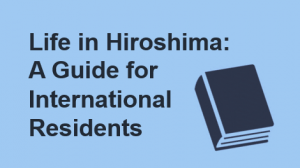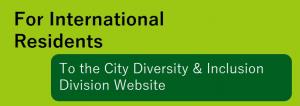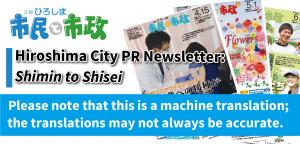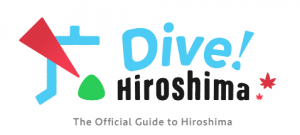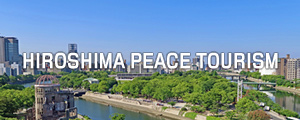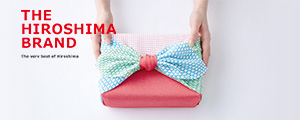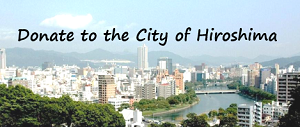本文
Conveying the Realities of the Atomic Bombing to Future Generations
1. Preserving and conveying A-bombed buildings and trees for future generations
(1) Subsidies for private A-bombed buildings and trees
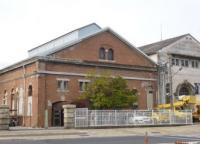 In order to preserve and utilize A-bombed buildings and trees remaining in the city as precious reminders of the bombing, we grant subsidies to private sector preservation works for A-bombed buildings and revitalizing treatments for the trees.
In order to preserve and utilize A-bombed buildings and trees remaining in the city as precious reminders of the bombing, we grant subsidies to private sector preservation works for A-bombed buildings and revitalizing treatments for the trees.
As of June 1, 2023, there are 86 buildings, 6 bridge girders, and 160 trees registered as A-bombed buildings, bridges, and trees.
(2) A-bombed trees monitoring program
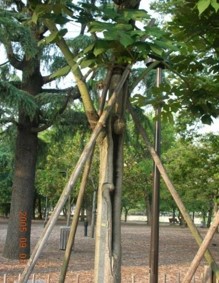 We work with a tree doctor who monitors the conditions of A-bombed trees, creates their medical charts, and provides revitalizing treatments for the trees.
We work with a tree doctor who monitors the conditions of A-bombed trees, creates their medical charts, and provides revitalizing treatments for the trees.
(3) Touring A-bombed buildings and trees
We offer a guided tour of A-bombed buildings and trees with experts to provide visitors with an opportunity to learn about the realities of the atomic bombing.
(4) Manage the Exhibit Facility for Atomic-Bombed Remnants
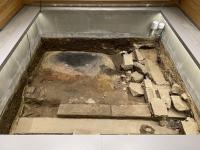
2. Improving preservation measures for a collection of materials at Hiroshima Peace Memorial Museum
In order to prevent the deterioration of the materials exhibited at the Main Building, A-bomb artifacts and original drawings of A-bomb survivors are replaced on a regular basis. Deterioration checks and necessary treatments are also implemented for photos, the conditions of which are the most serious concern among the materials stored at the Peace Memorial Museum, as well as for the A-bomb artifacts and survivors' drawings. The conditions of the museum's storage and exhibition rooms are being examined for improvement.
3. Collecting A-bomb artifacts
With the aim of enriching the exhibition contents of the Peace Memorial Museum, we conduct surveys on and collect A-bomb artifacts owned by survivors and bereaved families, photographs and other materials owned by museums and libraries overseas as well as documents and information related to the history of the museum. In conjunction with A-bomb exhibitions, we visit museums and other related facilities located in the area in order to discuss and coordinate future cooperation in carrying out reciprocal exhibitions and other joint initiatives.
4. Peace study workshops
We offer peace study workshops taught by lecturers to assist in peace education at elementary, junior high, and high schools among others.
5. Youth Peace Volunteer Program
We support the Youth Peace Volunteer Program that offers high school and university students in Hiroshima the opportunity to learn about the importance of peace and spread the Will of Hiroshima through giving explanation about the realities of the atomic bombing in English to international visitors in Peace Memorial Park.
6. Hiroshima Peace Volunteer Program<外部リンク>
We have a citizens' volunteer program to encourage residents to get involved in passing down the legacy of the atomic bomb. Volunteers, who have been recruited publicly, offer explanations about the exhibition at the Peace Memorial Museum and monuments in Peace Memorial Park.
7. Supporting volunteer staff at Hiroshima Peace Memorial Museum
We systematically provide integrated and continuous training to volunteers who are involved in programs offered at the Peace Memorial Museum in order to ensure that they convey correct information regarding the realities of the atomic bombing to visitors.
8. Providing hibakusha testimonies to audiences abroad via video conference
We arrange hibakusha testimonies via live video conferences to communicate the realities of the atomic bombing to those overseas and to raise international public support for nuclear weapons abolition.
9. Sharing hibakusha testimonies with students visiting Hiroshima
In order to communicate the realities of the atomic bombing and to raise awareness of peace, we provide students visiting Hiroshima on school trips with an opportunity to listen to hibakusha testimonies and/or A-bomb Legacy Successor lectures and watch A-bomb documentary films.
10. Offering A-bomb Legacy Successor lectures
We offer lectures from A-bomb Legacy Successors<外部リンク> and Hibakusha Family Member Legacy Successors in English and Japanese at the Peace Memorial Museum, free of charge and without any need to book. We also dispatch A-bomb Legacy Successors and Hibakusha Family Member Legacy Successors to venues in the city without charge upon request from schools or other entities.
11. Training official A-bomb Legacy Successors
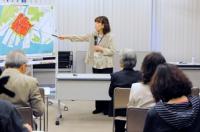 Because of the advanced age of our hibakusha, we have a 2-year program to train interested individuals as official A-bomb Legacy Successors who inherit and communicate the hibakusha experiences and desire for peace.
Because of the advanced age of our hibakusha, we have a 2-year program to train interested individuals as official A-bomb Legacy Successors who inherit and communicate the hibakusha experiences and desire for peace.
Moreover, since 2022, we began a 2-year training program for Hibakusha Family Member Legacy Successors to enable members of hibakusha families to inherit and convey a wider variety of hibakusha experiences.
[Number of applicants]
| Year | 2012 | 2013 | 2014 | 2015 | 2016 | 2017 | 2018 | 2019 | 2020 | 2021 | 2022 |
| A-bomb Legacy Successor | 137 | 68 | 44 | 69 | 47 | 47 | 72 | 61 | 42 | 51 | 48 |
| Hibakusha Family Member Successor | - | - | - | - | - | - | - | - | - | - | 54 |
12. Promoting the “Hiroshima for Global Peace” Plan
In cooperation with the Hiroshima Prefectural Government, the City of Hiroshima carries out supporting projects for the “Hiroshima for Global Peace” Plan<外部リンク>, which the prefectural government compiled to achieve lasting world peace.
13. Management and administration of Hiroshima Peace Memorial Museum
The Main Building of the Peace Memorial Museum<外部リンク> opened on August 24, 1955. Construction for earthquake-resistance to the Main Building, which is designated as one of the National Important Cultural Assets of Japan, and other repair work was carried out, and, at the same time, a total renewal of the exhibition and alterations to the visitor route were conducted in order to showcase the actual damage wrought by the atomic bombing and the inhumanity of nuclear weapons in a way that was easier to understand. After the East Building reopened in April 2017, the Main Building reopened on April 25, 2019.
In addition to the management and administration of the museum, our city collects, stores, and displays materials related to peace and the atomic bombing, and provides opportunities to contemplate peace through peace studies and sharing the A-bomb experiences, among others. We also conduct investigations and research, hold exhibitions, and strengthen our public relations via the Internet.
*In FY2022, a total of 1,126,381 (339,683 school trip students, 145,118 non-Japanese) people visited the museum.
14. Creating peace study materials for small children
For studying about peace prior to visitng the Peace Memorial Museum or peace education at home, we create and distribute the material for peace studies for children under 9 years old.



